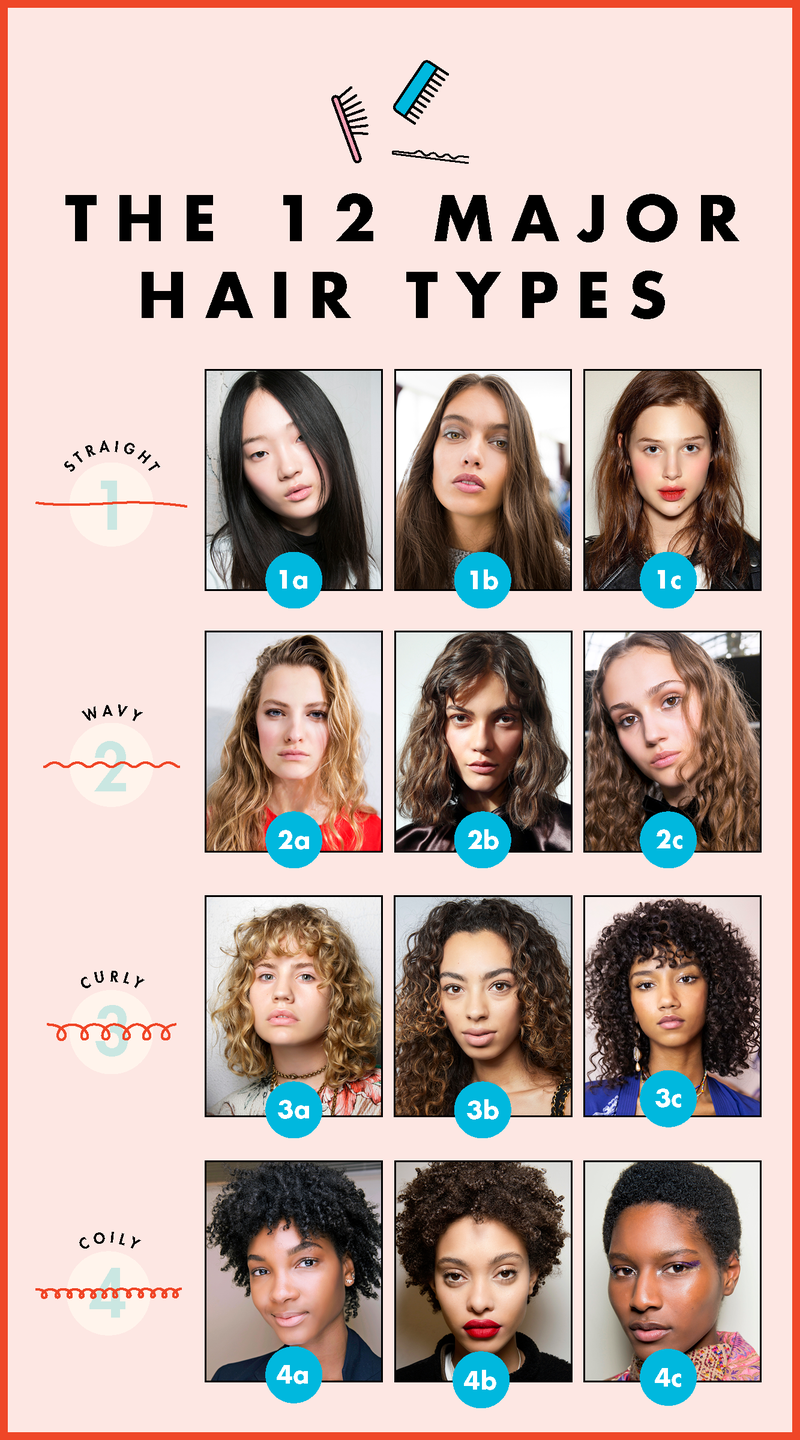Fact: There Are 12 (!!) Different Hair Types—Here's How to Style Yours

So, here’s the thing about hair types: They don’t play by any rules. You might have coarse waves mixed with fine curls, or a smattering of coils and tight textures, or stick-straight hair that poofs and frizzes under the right (wrong?) conditions. Which means there’s no universally correct hair product, routine, or really even classification system that applies to every hair type in the entire world. Womp.
That being said, enthusiasts and hairstylists (ahem, Andre Walker, the father of hair-typing) have managed to break them down over the decades into four very broad, very general categories: straight, wavy, curly, and coily, all in an effort to help you figure out how to take care of and style your hair with the least frustration. Though you might have, quite literally, three of these types on your head right now (see?! No rules!), keep reading to see how to work with all of them.

What’s my hair type?
Now isn’t that the zillion-dollar question? To save you from the hell that is comparing your hair to random photos on the internet (see: me, all throughout middle school), here’s the basic rundown of the four main hair types:
Type 1: straight hair
Type 2: wavy hair
Type 3: curly hair
Type 4: coily/zigzag hair
But, like, duh. You probably already figured that out. So let’s break it down even further.

TYPE 1: Straight hair
Straight hair can range from slippery and thin to thick and poofy. But one thing all straight hair types have in common? That megawatt shine, thanks to the fact that the oil from your scalp can easily slip and slide down the lengths of your strands to keep them moisturized and healthy. Though some argue there's only one type of straight hair—straight—I'm of the belief there's a spectrum of textures out there. Ahem:
Type 1a
This tends to be the flattest, thinnest, and silkiest of the straight hair types. Keeping a bobby-pin or an elastic in your straight hair is a magic trick. Your BFF: texturizing spray.
Type 1b
Still straight, but with some bends and a few coarser strands. Your biggest enemy is greasy roots, rather than puffiness and dry ends. Your BFF: dry shampoo.
Type 1c
Thicker and coarser, which means also more prone to frizz, poofiness, and dryness. If your straight hair is also damaged (hi, chemical, color, and heat treatments), you’ll likely fall into the 1c type. Your BFF: weekly hair masks.

TYPE 2: Wavy hair
Wavy hair tends to have definitive—and multiple—bends from roots to tips. Meaning if your hair has “just, like, one or two weird bumps” in it, you’re probably looking at type 1 straight hair, versus true, type 2 wavy hair. Type 2 waves can range from perfect-looking beachy waves to fluffy, undefined waves, and they're also one of the most easy-to-play-with hair types.
Type 2a
Unlike with 1c hair, 2a hair strands have a flat S-shape pattern that gives them their wave. 2a hair tends to be finer and flatter and can still be easily blown out and straightened. Your BFF: sea-salt sprays to encourage your natural wave.
Type 2b
2b waves have a slightly more defined S-shape—usually with a fine and/or medium thickness—and is a bit more prone to frizz and poofing, especially if your hair is damaged. Your BFF: a wave-enhancing mousse.
Type 2c
Still mostly S-shaped waves, but with a few loose curls and coarser textures mixed in. 2c hair tends to frizz easily and loose definition fast. Your BFF: a lightweight curl cream.

TYPE 3: Curly hair
In order for you to be part of the curly-hair club, your hair has to have actual curls—i.e., pieces that spiral around themselves like a spring, versus pieces that just wave back and forth in a flat S-shape. It’s common—and likely—to have a mix of curl textures (and even some waves!) on your head at once.
Type 3a
Unlike 2c hair, which has mostly waves and a few loose curls, 3a hair is mostly loose curls and a few waves. 3a curls tend to be finer, easily blown out, and super reactive to the elements (humidity! Wind! Dryness!). Your BFF: a curl-enhancing mousse.
Type 3b
3b curls usually have the circumference of your finger or a marker. These curls are springier and tighter than 3a curls, but they’re also more prone to dryness and frizz. Your BFF: a leave-in conditioner.
Type 3c
3c curls are noticeably tighter than 3b curls—think the size of a straw or pencil—and thickly packed together, giving your hair major volume. They’re also the most prone to dryness and breakage of the type 3 curls. Your BFF: a protein-rich oil.

TYPE 4: Coily hair
Coily hair can have a mix of textures that range from a tightly coiled, spring-like pattern (S-shape) to a zigzag pattern that doesn’t actually curl around itself (Z-shape). Because of their kinks and angles, scalp oils can’t easily lubricate your hair strands, making type 4 hair the most fragile, dry, and damage-prone of all hair types—BUT also the most versatile to styling.
Type 4a
4a hair has the tightest, smallest coils—often mixed with some 3c curls—that can just barely wrap around a crochet needle. Your coils can lose definition and moisture fast, which means your wash-and-go BFF? A curl gel for finger-coiling.
Type 4b
Rather than curling or coiling around themselves, 4b (and c!) strands bend in a sharp, zigzag shape and have the circumference of a spring in a ballpoint pen. 4b hair is more prone to shrinkage than 4a, so keep hair stretched and defined with your new BFF, an elongating gel.
Type 4c
4c’s Z-shape pattern is way tighter than 4b’s and naturally has fewer cuticle layers than any other hair type (FYI: The cuticle retains hydration and protects hair from damage), meaning it needs moisture, moisture, and more moisture. Your BFF: an emollient-rich cream.
You Might Also Like


